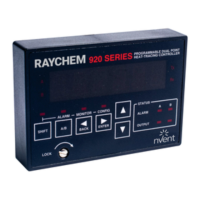24 / 82
EN- Raychem920series-IM-H5687405/15
INDUSTRIAL HEAT TRACING SOLUTIONS
3.5.15 TS 1 HIGH LIMIT CUTOUT
Purpose: When enabled, the TS 1 HIGH LIMIT CUTOUT feature will override the CONTROL
SETPOINT temperature and force the controller output off if the TS 1 reading exceeds the HIGH
TS 1 ALARM temperature setting. This is a non-latching condition, so once the TS 1 reading drops
below the HIGH TS 1 ALARM temperature setting, the controller will resume normal operation.
Setting: ENABLE or DISABLE
Procedure: Enable or disable the cutout feature as desired.
IMPORTANT:
• TheTS1HIGHLIMITCUTOUTfeatureoverridesanautocycletest.Apendingautocyclewill
be initiated immediately after the TS 1 tempera-ture drops below the HIGH TS 1 ALARM
temperature setting.
• IfaTS1failureoccursandtheTS1HIGHLIMITCUTOUTfeatureisenabled,theswitchoutput
will latch off regardless of the TS CONTROL MODE setting or the TS FAIL MODE setting.
• IftheTS1HIGHLIMITCUTOUTfeatureisenabled,thentheHIGHTS1ALARMtemperature
setting can be set, regardless of whether the HIGH TS 1 ALARM is enabled.
3.5.16 TS 2 TYPE (V3.11 AND UP)
Purpose: This parameter specifies the type of RTD that is connected to the HTC’s TS 2 input.
Setting: 3-wire 100 Ω platinum or 2- (or 3-) wire 100 Ω nickel-iron (Ni-Fe)
Procedure: Select the type of RTD that is connected to the TS 2 input.
IMPORTANT: If a 2-wire 100 Ω nickel-iron (Ni-Fe) RTD is selected then the TS 2 LEAD RESISTANCE
must be entered (see section 3.5.17 on page 25).
3.5.17 TS 2 LEAD RESISTANCE (V3.11 AND UP)
(For Ni-Fe RTDs only)
Purpose: This parameter specifies the lead resistance of a 2-wire nickel-iron RTD connected to
the HTC’s TS 2 input.
Range: 0 to 20.00 Ω
Procedure: Measure the resistance of one of the nickel-iron RTD leads (from the RTD to the HTC’s
TS 2 input) and use this value as the TS 2 LEAD RESISTANCE.
3.5.18 TS 2 HIGH LIMIT CUTOUT
Purpose: When enabled, the TS 2 HIGH LIMIT CUTOUT feature will override the CONTROL
SETPOINT temperature and force the controller output off if the TS 2 reading exceeds the HIGH
TS 2 ALARM temperature setting. This is a non-latching condition, so once the TS 2 reading drops
below the HIGH TS 2 ALARM temperature setting, the controller will resume normal operation.
Setting: ENABLE or DISABLE
Procedure: Enable or disable the cutout feature as desired.
IMPORTANT:
• TheTS2HIGHLIMITCUTOUTfeatureoverridesanautocycletest.Apendingautocyclewill
be initiated immediately after the TS 2 tempera-ture drops below the HIGH TS 2 ALARM
temperature setting.
• IfaTS2failureoccursandtheTS2HIGHLIMITCUTOUTfeatureisenabled,theswitchoutput
will latch off regardless of the TS CONTROL MODE setting or the TS FAIL MODE setting.
• IftheTS2HIGHLIMITCUTOUTfeatureisenabled,thentheHIGHTS2ALARMtemperature
setting can be set, regardless of whether the HIGH TS 2 ALARM is enabled.
3.5.19 VOLTAGE SOURCE (V3.11 AND UP)
Purpose: This parameter specifies which voltage source the HTC should use for its voltage
measurements.
Setting: POINT A or POINT B or FIXED
Procedure: If the HTC is not powered from a dedicated switch interface an alternate voltage source
can be selected. If a fixed constant voltage value is to be used then that FIXED VOLTAGE SETTING
must also be entered (see section 3.5.20 on page 26).

